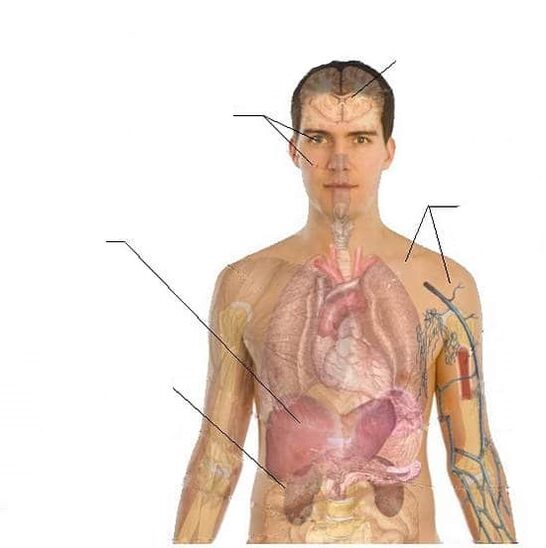More than half of the world's population suffers from parasites. This is due to the fact that in some cases the infection is asymptomatic, but this does not relieve the carrier of pathogenic complications in the human body. In most cases, you can get rid of parasites with folk remedies at home, for which you need to know the types, symptoms and features of treatment of each pathogen.
Causes
Parasites in the host's body come into contact with the outside environment. All ways of disease transmission are divided into 4 main types:
- Food contamination (with dirty water or food, unwashed hands).
- Contact and house penetration (through pets and other infected people).
- Transmissible injection (due to insect bites).
- Cutting or active infection (penetration of parasitic larvae through skin and mucous membranes in contact with contaminated soil or water).
Such a disease can also be transmitted through unprotected sexual intercourse, in which Trichomonas enters the human body.
Types of parasites
All bacteria that cling to the human body can be divided into three major groups:
- Protozoa. This group has many species, most of which can be infected with lamblia, trochimonade and toxoplasmosis. It can appear on different parts of the body.
- Worms (helminths). These include pinworms, roundworms, pork and cattle tapeworm, echinococcus and other species. Such parasites develop in the patient's intestines.
- Ectoparasites such as ticks or lice. Parasitizes human skin (hairy or exposed epidermis).
Ectoparasites are the safest of all species. Protozoa and worms can develop in the body of an infected person for months, disrupting the functioning of internal organs, but without giving specific signs of their formation. Symptoms of worms are often associated with general discomfort or diseases of the gastrointestinal tract, pancreas. To prevent the development of the disease, it is necessary to know the signs and symptoms of the appearance of parasitic "guests" in the body.
signs and symptoms
The symptoms of different types of pathogenic microorganisms in the body can be different. On average, the following clinical picture can be distinguished:
- frontal headache and irritability;
- weakness, fatigue;
- anorexia and nausea, resulting in weight loss;
- intestinal dysfunction, pain;
- skin rash;
- increase in body temperature;
- anemia (whitening of the skin and mucous membranes of the body).

Microorganisms live at the expense of their owners, so the human body tends to wear and tear. Symptoms worsen as the pathology progresses, so treatment should be started when the first symptoms appear.
Effective treatment with folk recipes
You can get rid of parasites with folk remedies at home using various recipes. Their choice depends on the type of pathogen.
Protozoan microorganisms (protozoa)
These microorganisms can parasitize different parts of the human body. It can infect the human intestines (toxoplasmosis, amoeba), blood and heart (trypanosomes), and the genitourinary system (Trichomonas). Folk recipes against this type of parasites suggest using the following:
- Enemas with cornel water.To do this, dilute a few tablespoons of cornstarch in 2 liters of water with salt. Washing should be repeated several times a day. The method effectively helps fight protozoa in the gut.
- Garlic enemas.5-6 cloves of garlic should be boiled, filled with milk, then cooled. Washing with the resulting product is repeated 2-3 times a day.
With the help of pepper and herbs, you can get rid of this type of parasite. I recommend adding more onions, garlic, pepper and horseradish, cinnamon to baked goods and cloves to your diet.
Getting rid of giardiasis
Separately, attention should be paid to the destruction and treatment of the simplest lamblia, which can penetrate almost any organ of the user's body. There are several recipes for such parasites:
- Infusion of lilac flowers. Dried lilac flowers should be poured with alcohol and left for 7 days. After this period, you need to start each meal with a teaspoon of such a tool.
- Pumpkin seeds. 300 grams of peeled seeds should be crushed in a solution until a powder. Add a few tablespoons of honey and boiled water. The drug can be taken immediately, at the same time as mussels to increase its effectiveness.
An effective remedy for parasites in the pancreas is a mixture of several herbs:birch shoots (3-4 teaspoons), tansy (4 teaspoons), yarrow and horsetail (several teaspoons each). Dried herbs are boiled in boiling water. The collection should be taken 2-3 times a day, the course of treatment is one week.
Sauerkraut helps the human liver to form lamblia,, or rather its salt water. You need to drink 3-4 sips of salt water before meals. Strawberries, dill seeds or cumin seeds can also help.
Removal of worms
We use the following tools to effectively treat worm infestation in humans:
- Infusion with garlic and horseradish.In the same proportion, both alcohol-filled ingredients are brewed for at least a week, then taken one tablespoon per day.
- Avran decoction.The leaves of the plant, diluted 1: 3 with water, boil on low heat for about half an hour. Drink a teaspoon every half hour.
- Pomegranate peel,is filled with boiled water, take 1 teaspoon before meals.
- Roasted and ground coriandercan also help worms. The course of treatment is 5 days, can be sprinkled with food.
Ectoparasites
Ticks, fleas, itching are different manifestations of ectoparasites. Such microorganisms live on a person's skin and are transmitted - in contact with clothing or a carrier. Home treatment is done locally.
Killing parasites involves applying to an infected area:
- kerosene;
- a mixture of vinegar and salt; decoction of burdock
- ;
- A mixture of mint and pomegranate juice.
Laundry or antibacterial soap helps effectively in the treatment of ectoparasites at home, resin can be used.
General recipes and methods
There are also tools that can rid the homeowner of all kinds of protozoa and helminths. The most common folk recipes for all kinds of parasites in the human body:
- Green walnut shell.15 hazelnuts are mixed with two glasses of vodka. The remedy is brewed for a month. The tincture is strong, so dilute a few drops daily in 250 ml of boiled water.
- Dried wormwood(seeds) are pulverized. You can take half a teaspoon of this medicine a day. You can also make a remedy with clove seeds (one and a half teaspoons a day).
Dried calamus, thyme and calendula seeds are also effective. In addition, there are recipes that work locally. For example, you can treat an intestinal infection by taking the following foods:
- fermented dairy products.A few days can be spent on a kefir diet to increase efficiency. In addition to sour milk, you can eat dry brown bread.
- Apricots,figs, prunes and raisins. Such fruits can be taken daily, including for prophylaxis.
- Salt water and sauerkraut,, should be drunk before meals (2-3 sips).
- Aloelemon juice is added. The juice of one ripe fruit is added to 2 teaspoons of aloe. You need to drink such a tool in the morning on an empty stomach.
You can use the following to cleanse the human liver from the simplest invasions:
- is a beet;
- carrot, cucumber juices;
- lemon juice with a few tablespoons of olive oil;
- herbs: oak bark, chamomile, tansy;
- The antiparasitic tea also proved itself very well in the monastery.
Treatment of parasites with folk remedies is extremely effective, but you should not neglect to consult a doctor. Diagnosis and advice from an experienced specialist will help guide treatment in the right direction.
Prevention
You can prevent intrusion into your body. Prevention of parasites in the human body consists of the following rules:

- comprehensive hand hygiene;
- washing fresh vegetables and fruits before eating;
- use of boiled and filtered water, not raw;
- dishes that have undergone comprehensive heat treatment;
- monitor the presence of parasites in the pet (visit a veterinarian);
- to disinfect children's toys, household items;
- Do not swim in questionable pools.
When infected with parasites, treatment is required not only for the carrier they know, but for all family members and even pets. This will reduce the risk of recurrence of the disease.






































